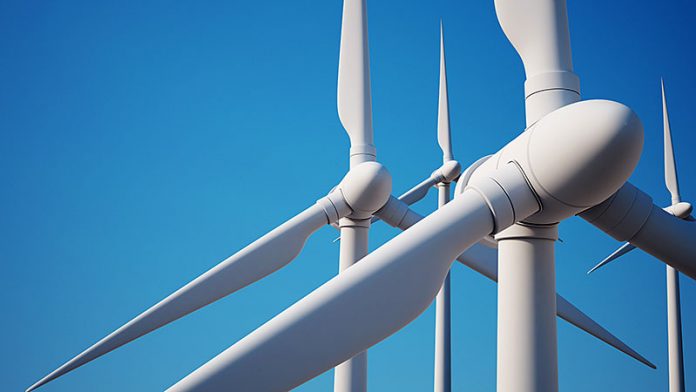Find Info For
Quick Links
August 24, 2022
Purdue University engineers Jun Chen and Lizhi Shang have designed a powertrain system to improve turbines that generate wind energy and marine hydrokinetic energy. The design transmits power from the low-speed high-torque turbine to the high-speed, low-torque generator. It also uses water as the hydraulic fluid. (iStock photo: XtockImages)
WEST LAFAYETTE, Ind. – Purdue University engineers have designed a low-speed, high-torque powertrain system to reduce the operation costs, maintenance costs and environmental contamination of turbines that generate wind energy and marine hydrokinetic energy. A prototype is scheduled to be tested and analyzed at the university.
Jun Chen, a professor in the School of Mechanical Engineering, and Lizhi Shang, an assistant professor in the Department of Agricultural and Biological Engineering and School of Mechanical Engineering, said using a turbine is the most effective approach to harvest wind energy and marine hydrokinetic energy. It requires a powertrain system to transmit energy from the turbine to an electric generator.
“A turbine usually features high-torque, low-speed operation, but an electric generator prefers high, constant speed,” Chen said. “The speed ratio between the generator and the turbine can be higher than 100:1 and requires at least a three-stage gearbox.”
A conventional multistage gearbox has a fixed gear ratio, so an electric generator must run at variable speeds. Shang said the efficiency of a multistage transmission from turbine to generator is suboptimal. The fixed transmission ratio of a conventional turbine gearbox also limits generator efficiency.
“There have been some attempts to use hydrostatic transmissions in wind turbine applications,” Shang said. “The main obstacles are maintenance and environmental concerns. They demonstrate low efficiency, frequently required maintenance and oil leakage.”
Chen and Shang’s powertrain design transmits the power from the low-speed, high-torque turbine to the high-speed, low-torque generator while maintaining constant generator speed.
Chen said the design allows for the detachment of the generator from the turbine.
“The generator can be placed at the ground level of wind turbines or the water surface level for marine hydrokinetic turbines,” he said. “This reduces the nacelle weight of the turbine and simplifies maintenance.”
Shang said the design also allows for smart, collective energy harvesting using an array of individual turbines and one or more centralized generators.
“Turbines can be connected fluidly to their neighbor turbines,” he said. “A common, high-pressure fluid network can be established to connect all the turbines and generators of a collective turbine array. The network allows for strategically selective operation of the generator to keep some of the generators running at their most efficient points and shut down the rest to reserve lift time.”
The technology includes the hydraulic unit design, system architecture, control and integration strategy, and supplemental systems for filtration, cooling, bearing and sealing. It can be implemented in existing turbines with only moderate modifications. The design also uses water as the hydraulic fluid, which allows for generator speed regulation, Chen said.
“The energy losses for regulating electric power frequency can be eliminated,” he said. “Compared to an existing hydrostatic wind turbine powertrain, our technology is more efficient, up to 90%. Water is a better working fluid for long-distance hydraulic power transmission, which enables collective energy harvesting. It is easy to refill, and leakage causes less environmental damage than conventional mineral-based hydraulic oil.”
The next step in developing the new powertrain is to test the prototype in a towing tank at Purdue. Data will be collected, measured and analyzed, which will lead to further improvements on the design.
Chen and Shang disclosed the powertrain design to the Purdue Research Foundation Office of Technology Commercialization. OTC has applied for a patent to protect the intellectual property. Industrial partners seeking to further develop or license the technology should contact Dhananjay Sewak at [email protected].
About Purdue University
Purdue University is a top public research institution developing practical solutions to today’s toughest challenges. Ranked in each of the last four years as one of the 10 Most Innovative universities in the United States by U.S. News & World Report, Purdue delivers world-changing research and out-of-this-world discovery. Committed to hands-on and online, real-world learning, Purdue offers a transformative education to all. Committed to affordability and accessibility, Purdue has frozen tuition and most fees at 2012-13 levels, enabling more students than ever to graduate debt-free. See how Purdue never stops in the persistent pursuit of the next giant leap at https://stories.purdue.edu.
About Purdue Research Foundation Office of Technology Commercialization
The Purdue Research Foundation Office of Technology Commercialization operates one of the most comprehensive technology transfer programs among leading research universities in the U.S. Services provided by this office support the economic development initiatives of Purdue University and benefit the university’s academic activities through commercializing, licensing and protecting Purdue intellectual property. In fiscal year 2021, the office reported 159 deals finalized with 236 technologies signed, 394 disclosures received and 187 issued U.S. patents. The office is managed by the Purdue Research Foundation, which received the 2019 Innovation and Economic Prosperity Universities Award for Place from the Association of Public and Land-grant Universities. In 2020, IPWatchdog Institute ranked Purdue third nationally in startup creation and in the top 20 for patents. The Purdue Research Foundation is a private, nonprofit foundation created to advance the mission of Purdue University. Contact [email protected] for more information.
Writer: Steve Martin, [email protected]
Sources: Jun Chen, [email protected]
Lizhi Shang, [email protected]
Purdue University, 610 Purdue Mall, West Lafayette, IN 47907, (765) 494-4600
© 2015-22 Purdue University | An equal access/equal opportunity university | Copyright Complaints | Maintained by Office of Strategic Communications
Trouble with this page? Disability-related accessibility issue? Please contact News Service at [email protected].






